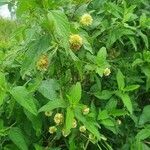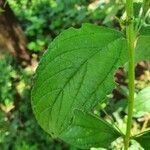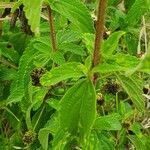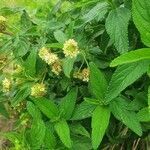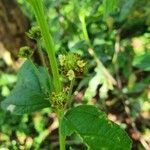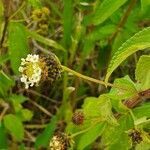Shrubby herb or shrub (even described as a small tree) 1.2–4.5(–6) m. tall; stems densely hairy with ± rough tubercle-based hairs; bark rough, corky, deeply longitudinally fissured.. Leaf-blades ± stiff, scented, elliptic, ovate, oblong-lanceolate or-elliptic, 1.5–11.5 cm. long, 0.6–3.7(–5) cm. wide, rounded to acute at the apex, cuneate to truncate at the base, rough or scabrid above with tubercles from which the hairs very soon break off, rugose and bullate above with venation impressed, softly hairy and glandular beneath with long white hairs and venation raised; margins closely finely to more coarsely crenate-serrate save at base and rough with tubercles; petiole 2–7 mm. long.. Inflorescences 1–3 per axil, globose to hemispherical or oblong-ovoid, 0.5–2 cm. long and wide, mature peduncles 2–6.5(–8) cm. long; lowest bracts ovate, 8–10 mm. long, 4 mm. wide, acute to acuminate, pubescent or rough with tubercles, others smaller, triangular-ovate to-lanceolate, 5 mm. long, 2 mm. wide, acute to acuminate, pubescent to woolly and glandular.. Calyx bilobed, 1.2 mm. long, densely pubescent.. Corolla cream to yellow-green with orange-yellow or yellow centre; tube 3–4 mm. long, puberulous and glandular above; larger lobes semi-circular, 1–1.5 mm. long, 1.5–2 mm. wide.. Mericarps half-ellipsoid, 1.5 mm. long, 1 mm. wide, white-granular on inner face, densely pubescent outside.
More
A herb or shrub. It grows 1-2 m high. It has many branches. It is aromatic. The stems are hairy. The bark is rough and there are cracks along it on old stems. The leaves are oval and 10 cm long. They are opposite and have rounded teeth along the edges. They are rough above and softly hairy underneath. The flowers are white or cream. The fruit are made up of 2 dry sections with a seed in each. They are small and red but edible.
Bushland, woodland, rough grassland, often on volcanic soil or lava rocks. An important part of long-destroyed forest sites where it may be locally dominant in secondary bush; margins of evergreen woodlands, at elevations from 400-2,600 metres.
More
It is a tropical plant. It grows in grassland and often on rocky ground. It grows between 400-2,550 m altitude.
